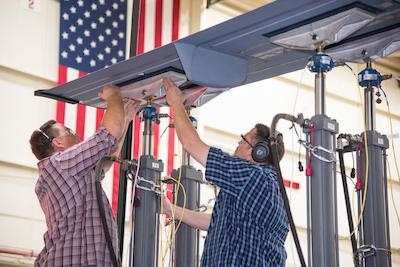Instruments Will Monitor Flight Loads On PAT Wing
A uniquely instrumented wing will allow researchers to investigate advanced methods of monitoring flight loads, which could lead to improved flight safety.

The Passive Aeroelastic Tailored, or PAT, wing is expected to arrive later this year at NASA Armstrong Flight Research Center in California. The uniquely designed composite wing is lighter, more structurally efficient and has flexibility compared to conventional wings, said Larry Hudson, Armstrong Flight Loads Laboratory chief test engineer.
The layout of the fibers that make up the PAT wing are specially tailored and the performance of that design will be validated during these tests. Future commercial aircraft could use this wing building design to maximize structural efficiency, reduce weight and conserve fuel. “It’s called a passive tailored wing because the structural efficiency is contained within the construction of the wing, it’s not an active system that is controlling the structural efficiency of the wing, it’s the composite layout,” Hudson explained.
The PAT wing was developed by Aurora Flight Sciences of Virginia and fabricated at the company’s manufacturing plant in Mississippi. The project is funded by the Aeronautics Research Mission Directorate through the Advanced Air Transport Technology project.
Until the PAT wing arrives, loads lab staff are working on the Calibration Research Wing, or CREW, in a similar test fixture for proficiency testing. CREW will be used as a pathfinder for the PAT wing. The two wings share similar instrumentation layout and collect similar data, which is why the CREW wing is a valuable hands-on dry run to collect data, learning how to analyze data and complete calibrations.
One of the major differences in the test architecture is the overhead loading system required to handle the significantly larger wing tip displacement inherent with the longer and more flexible PAT wing.
Another research item is the extensive use of the Fiber Optic Sensing System, or FOSS, technology. FOSS will enable faster and more economical loads calibration of the wings in the future. FOSS uses hair-like optical fibers that are bonded to the wing’s surface and can provide thousands of strain measurements to determine wing shape and distributed load. “We will look at the limits of FOSS and how to maximize its use to help reduce the cost and schedule of loads calibration testing,” Hudson said.
Davis-Monthan Air Force Base in Arizona provided the MQ-9 (same kind of aircraft as NASA’s Ikhana) wing that serves as the CREW testbed. In 2007, Ikhana was the first large aircraft to fly with FOSS at Armstrong.
(Image provided with NASA news release. Jacob Roepel and Aaron Rumsey set the load pads for the calibration research wing, or CREW)
 Airborne 06.30.25: US v ADS-B Misuse, Natl STOL Fire, Volocopter Resumes
Airborne 06.30.25: US v ADS-B Misuse, Natl STOL Fire, Volocopter Resumes NTSB Prelim: Piper PA-23
NTSB Prelim: Piper PA-23 ANN FAQ: Submit a News Story!
ANN FAQ: Submit a News Story! Classic Aero-TV: One Mans Vietnam
Classic Aero-TV: One Mans Vietnam Klyde Morris (06.30.25)
Klyde Morris (06.30.25)



